|
|
 |
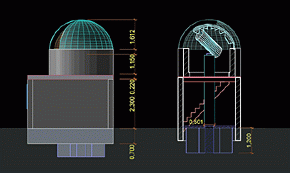
|
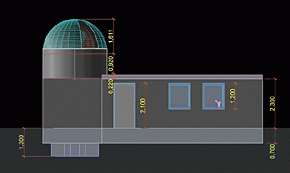
|
North Elevation
|
East Elevation
|
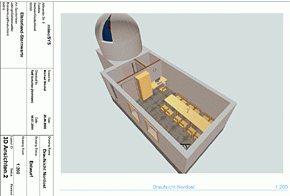
|
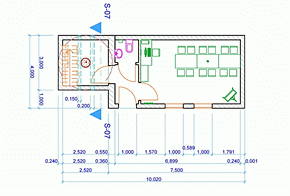
|
ground floor 3D
|
Ground floor
|
|
 |
|
|
 |
|
Planned instruments:
|
 |
Main instrument: 15" Astrograph from
LOMO (Russia).
Other telescopes:
- 5" (f/7) Omegon Apochromat
- Carl Zeiss JENA 100/1.000mm AS Refraktor
- Celestron 8 (this 3 are sponsoring by Hans Schumacher, Berlin)
- 10" / f/5.5 Intes-micro Maksutov-Newton
- H-alpha sunlight modul.
And for special operations: Intes MN-61 -
Intes 6" Maksutov-Newton -
Aperture: 152mm, focal length: 900mm = f/6, -
››
MN-61 gallery
Carl Zeiss JENA Astronomical camera 56 / 250 mm = f/4.5
[or wide field instrument]
ASA DDM85 mount with Direct Drive, 'periodic error' below 0,3"!
Cameras:
Starlight Xpress OSC SXV-M25C (APS-C Size, with 6MP) and 2 modificated Canon EOS.
Dome:
3-meter-Dome from ››
ScopeDome, with electronic control., Diameter 3.000mm,
height: 2.600mm, gap width: 1.000mm.
|
|
 |
|
|
 |
|
Location check with SQM + SQM-L
|
 |
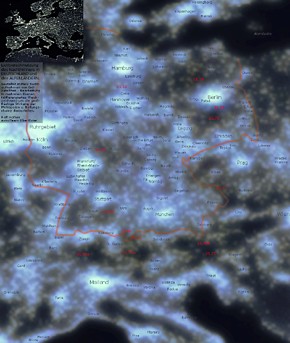
|
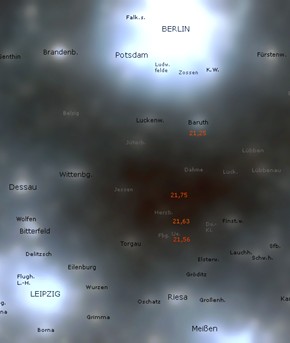
|
Quality of the night sky in central Europe.
In Germany and surroundings there remain only a few areas with real good
sky: The alps, some areas in bohemia, in the extreme south east of
Bavaria, in Mecklenburg and in Poland. Here you can find SQM values
above 21,70.
The best SQM values in Germany are given from northern Brandenburg:
21,81 mag/"2 (Prof. Dr. Thomas Möller, TU Berlin) and
21,78 mag/"2 (Dr. Andreas Hänel, Dark sky group).
|
Southern Brandenburg + northern Saxonia.
At our new location in Jeßnigk we measured SQM values up to 21,75. There
s only a small difference to the best values in northern Brandenburg.
But we have advantages concerning the metereological conditions (see below).
The real best astronomical conditions
you find in a small area near Herzberg.
|
|
 |
|
|
 |
|
Metereological conditions and seeing
|
 |
Approximately
at 1930 the army looked in entire Germany for a new and stratetic
important miltary airport. Their choice was Lönnewitz, 15 km
south of Herzberg. The climatic values showed a coincidence of some
fovourabel elements, which are also important for astronomy.
The southwest
of Brandenburg is located of the lee side of the german highlands. You find
here:
1. The least amount of clouds and rain
2. Few foggy days
3. Few wind
At
astronomical photos you can easy detect the quality of seeing.
Especially photographs from important events are therefore most
suitable: You can easy find photgraphs from different parts of Germany
an, of course, the world. The transit of the planet Venus in front of the sun
at Juni 8th 2004 was such an event. The appending photographs
are taken in southern Brandenburg and count to the sharpest around the world:
|
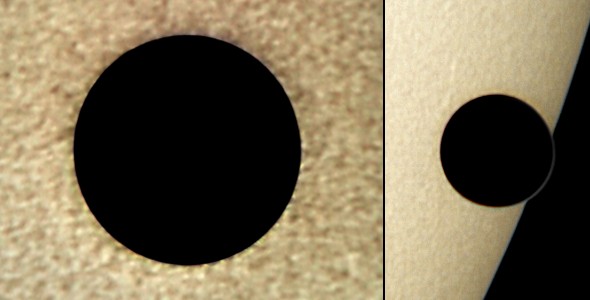
|
Transit of Venus 2004, taken with Intes 6"Maks.-Newton (left) +
105mm TMB Apo (ri.). © Ralf Hofner
|
|
 |
|
|
 |
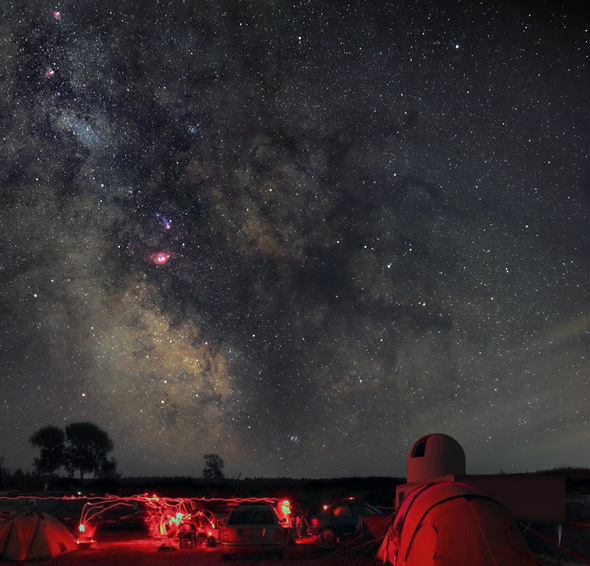
|
The
new Observatory will give a adequate silhouette at the HTT area: At
night and at day. The phtographic mountings show how our place will
look like if the observatory will be finished.
The both images from the photo composition above were not taken at the same time, but from nearly same place and
with the same exposure time. The lacation is not identical: M 7 is missing at the milky way photograph,
because it was taken at the end of May from the boarding house "Jericho" and therewith 300 meters near at the
horizon-covering mountain "Schappinberg" [Original picture here].
From the northern HTT meadow you
can not only see M6 (upper center) but also M 7, the most southern of all Messier objects. It will come visible one
hour before culmination.
Beside this the photograph shows the possibilities of Jeßnigk's sky even under less than optimal conditions.
Transparency at the zenith and near the horizon were good bis very good but not exceptionell good. If you look
minutely at the image you see the thin haze in the right bottom corner. The sun stood not deep below the horizon
at May 29th to get a truely dark sky.
And now a look at the future northern HTT meadow with observatory:
|
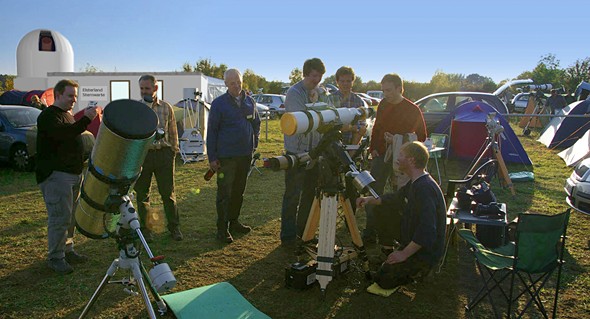
|
|
|
 |
 |
|
pictures of the construction work →
here.
|
|
 |
Every year we get a positive feed back from the visitors of the
Herzberger Teleskoptreffen (HTT): They praise the good weather conditions and the quality of the night sky.
We decided in 2008 to establish an astronomical Observatory at this place. There should
take place observation events at each new moon's weekend.
At the end of April 2009 the ››
1. AstroTreff Schwarze Elster took place. Michael Möckel,
a young IT business- man was a visitor of this event. At this time he was
looking for a place to establish his own observatory. Impressed by the
good sky of Jeßnigk (SQM-L values between 21.7 and 21.75) he decided to join the club "AstroTeam Elbe-Elster
e.V." and to support a club observatory at this place.
We'd like to
thank Michael for this engagement!
We also wish to thank the mayoress of Schönewalde, Ms. Irene Kluge and the
mayor of Jeßnigk, Mr. Gerwin Hinrich.
We are set the foundation
stone on the
››
HTT 2009.
We invite all
astronomers to join this project. This will be the first step into a large project.
We want to establish an Astronomical Center with expanded observation
facilities and rooms for overnight stay.
We ask all amateurs to join this project which makes one of the greatest
skies in Germany easy available for all of us.
|
|
 |
|
|
 |
|
Photographic location check
|
 |
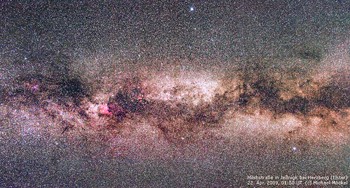
|
Milky way in Jeßnigk. © Michael Möckel
|
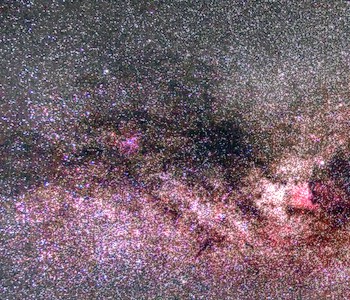
|
Detail from the image above with
northern coal sack.
We
took this photograph with the milky way only 20 degrees above the
horizon! The transparency of the sky was less than ideal this night
(SQM-L Ø 21,64). Nevertheless you can see, we have more than a regular
rural sky.
|
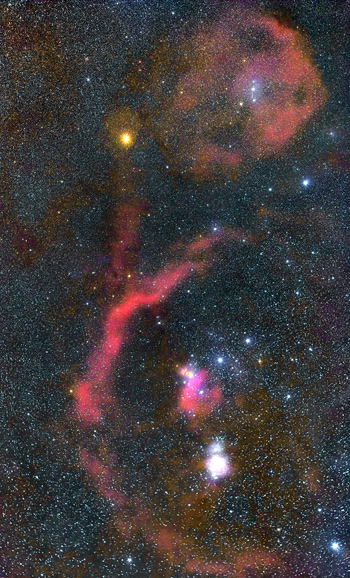
|
The nebulae regions in the Orion © René Merting.
This photograph reflects the not the best conditions at the HTT land.
It was created in September, when Orion reached only the half height of southeast ...
more
|
|
 |
|
|
 |
|
Visual observations
|
 |
Bernhard Engeser
is a very experienced observer and knows the sky in the alpes very
well. He checked the sky quality of southern Brandenburg with it's 18"
Newton telescope at two nights. The results in telegraphic style, most
used eyepiece focal length in parenthesises:
Gx Leo I: Oval, uniformly
distributed brightening (17 mm) ° GC Palomar 4: Not hard, at the
edge to direct vision (17 mm) ° Gx Holmberg II: Easy, direct vision
(22 mm) ° Gx Holmberg I: Uncertain °
Gx Holmberg IV: Easy. Elongated homogenous brightening without internal structure (22 mm)
Gx M101: Spiral structure conspicuous, many brightenings in the spirial arms,
5 H-II regions were visible (12 mm) ° Crescent nebula: Light bridge in the
center clear visible, ring nealy closed, structures in the brihgt part (1mm+[O-III]) °
Gx NGC 6240: Peculiar irregular structure (12 mm) °
End of first night.
GC Palomar 3: uncertain °
GC Palomar 5: uncertain °
Gx cluster Abell 2065: Only PGC 54846 was visible (17 mm) °
GC M13: Gorgeous! In its' vicinity lies Gx IC 4617,
visible at the edge to direct vision (13 mm) ° Gx Holmberg I:
Requires indirect vision (22 mm) ° Gx Holmberg V: Easy object (17 mm) °
Gx Holmberg VIII: Direct vison (17 mm) °
Gx Holmberg IX: Difficult, very faint brightening (16 mm) °
Gx M81: Outer spiral arms are structured (22 mm) °
Gx M82: Lots of structure, dark bar very contrasty (12 mm) °
PN M97: "Eyes" very clear (12 mm w/o filter) °
PN M57: central star indirect, not easy (400x) °
GC NGC 6749: diffuse and irregular brightening (22mm) °
End of second night. -
The complete report is avalaible only in german.
| |
 |
|
|
 |
|
Chronology
|
 |
Michael writes
a blog with the complete chronology and the newest information
(in german).
You can see the progess of the observatory's construction in our
Obersvatory gallery. |
|
 |
|
|
 |
›› Astronomical Center Schwarze Elster
‹‹
The
very favourable astronomical and meteorological conditions near
Herzberg are a large stimulus for us. We want all amateur astronomers
to have part at this fantastic sky. This is al large motivation for us
to proceed with the observatory project as quickly as possible. We
know that we cannot compete with Namibian or Chilenic sky. But or
region offers a very good rural sky and is conveniently situated for
most of Germany. Spontaneous observation meetings can be performed
quite easily. The continental influenced climate gives
very favourable conditions for astronomy. In autumn we have regularly a
very stable anticyclone here. A very good example gives the September
2008 which cold and cloudy. You have to look decades ago to find
such an astronomy-unfriendly autumn. Here near Herzberg we had
only three nights which could not be used for observations at all. At
least some hours of the other nights we had clear sky. At the end of
September or beginning of October you can travel to southern
Brandenburg to spend astronomical vacation here: You will have much
clear nights! If we get enough resonance from the astronomical
community we are ready to establish an Astronomical Center in Jeßnigk.
We think about more instruments in our observatory and about rooms
for overnight staying.
Dear astronomers! We are looking forward to receive
your suggestions ideas and may be conceptions!
We look for fellows & financial
sponsors!
Please send your proposals via
e-Mail.
You can give donations to the account:
Bank: Sparkasse Elbe-Elster
BLZ: 18051000
Konto-Nr.: 3320200347
Owner: Verein AstroTeam Elbe-Elster e.V.
We are a non profit organisation.
|
|
|